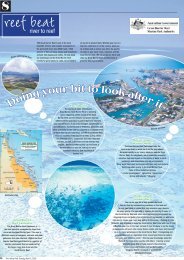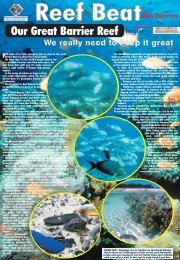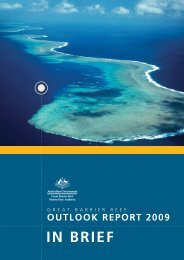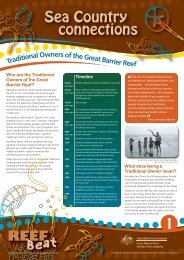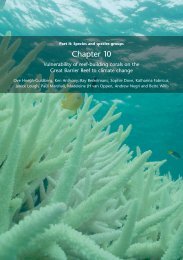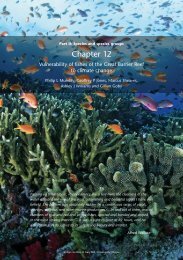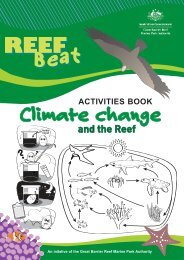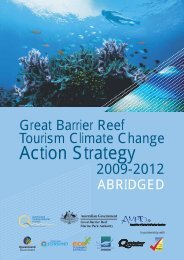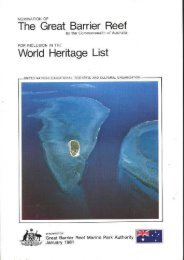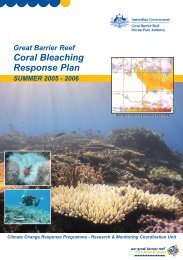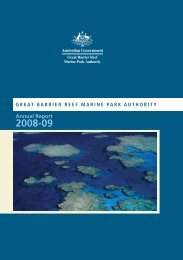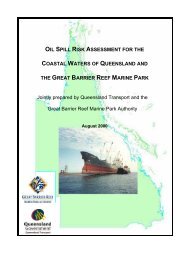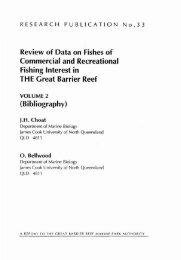Chapter 1: Introduction to the Great Barrier Reef and climate change
Chapter 1: Introduction to the Great Barrier Reef and climate change
Chapter 1: Introduction to the Great Barrier Reef and climate change
You also want an ePaper? Increase the reach of your titles
YUMPU automatically turns print PDFs into web optimized ePapers that Google loves.
Part I: <strong>Introduction</strong><br />
<strong>Chapter</strong> 1<br />
<strong>Introduction</strong> <strong>to</strong> <strong>the</strong> <strong>Great</strong> <strong>Barrier</strong> <strong>Reef</strong><br />
<strong>and</strong> <strong>climate</strong> <strong>change</strong><br />
David Wachenfeld, Johanna Johnson, Andrew Skeat, Richard Kenching<strong>to</strong>n,<br />
Paul Marshall <strong>and</strong> James Innes<br />
A reef such as is here spoke of is scarcely known in Europe, it is a wall of<br />
Coral Rock rising all most perpendicular out of <strong>the</strong> unfathomable Ocean,<br />
always overflown at high-water generally 7 or 8 feet <strong>and</strong> dry in places at<br />
low-water; <strong>the</strong> largest waves of <strong>the</strong> vast Ocean meeting with so sudden a<br />
resistance make a most terrible surf breaking mountains high especially as<br />
in our case when <strong>the</strong> general trade wind blowes directly upon it.<br />
Captain James Cook, August 1770
Part I: <strong>Introduction</strong><br />
1.1 Why do a vulnerability assessment?<br />
The <strong>Great</strong> <strong>Barrier</strong> <strong>Reef</strong> owes its genesis <strong>to</strong> a <strong>change</strong> in <strong>climate</strong> approximately twelve thous<strong>and</strong> years ago.<br />
As <strong>the</strong> last ice age ended, glaciers melted <strong>and</strong> sea level started <strong>to</strong> rise <strong>and</strong> stabilised at present levels<br />
about six thous<strong>and</strong> years ago, which is when <strong>the</strong> reef formed. It may seem ironic <strong>the</strong>n, that <strong>climate</strong><br />
<strong>change</strong> is now regarded as <strong>the</strong> single biggest threat <strong>to</strong> <strong>the</strong> future of <strong>the</strong> <strong>Great</strong> <strong>Barrier</strong> <strong>Reef</strong>. Yet, human<br />
influences on <strong>the</strong> global <strong>climate</strong> system are causing <strong>change</strong>s that have not been seen for hundreds of<br />
thous<strong>and</strong>s of years, at a pace that is likely <strong>to</strong> exceed anything experienced for many millions of years.<br />
Worldwide, l<strong>and</strong>scapes <strong>and</strong> ecological systems, <strong>to</strong>ge<strong>the</strong>r with <strong>the</strong> social <strong>and</strong> economic structures that<br />
depend on <strong>the</strong>m, are facing a new challenge that is truly global in scale. While few systems are likely<br />
<strong>to</strong> benefit from <strong>climate</strong> <strong>change</strong>, coral reefs are particularly vulnerable. Mass coral bleaching events,<br />
resulting when sea temperatures become unusually hot, have already caused serious damage <strong>to</strong> over<br />
16 percent of <strong>the</strong> world’s coral reefs 22 . Although <strong>the</strong> <strong>Great</strong> <strong>Barrier</strong> <strong>Reef</strong> has not suffered <strong>the</strong> levels of<br />
damage seen in many o<strong>the</strong>r regions, up <strong>to</strong> 5 percent of reefs were severely degraded in each of <strong>the</strong><br />
1998 <strong>and</strong> 2002 bleaching events. Projections of future sea temperatures suggest that coral bleaching<br />
could become an annual phenomenon in <strong>the</strong> course of this century, threatening <strong>to</strong> undermine <strong>the</strong><br />
physical <strong>and</strong> ecological foundations of this diverse <strong>and</strong> productive ecosystem.<br />
While we have been working <strong>to</strong> underst<strong>and</strong> <strong>the</strong> implications of increased sea temperatures for corals,<br />
o<strong>the</strong>r vulnerabilities are also coming <strong>to</strong> light. Temperature-sensitivities of o<strong>the</strong>r species, such as<br />
microbes, plank<strong>to</strong>n, fishes, marine turtles <strong>and</strong> seabirds indicate <strong>the</strong> potential for impacts throughout<br />
<strong>the</strong> trophic system. Changes <strong>to</strong> o<strong>the</strong>r environmental variables suggest o<strong>the</strong>r impacts on species <strong>and</strong><br />
habitats, possibly more subtle but also less reversible. The implications of ocean acidification for<br />
calcifying organisms such as corals <strong>and</strong> some plank<strong>to</strong>n, for example, could be profound.<br />
As our awareness of <strong>the</strong> immediacy <strong>and</strong> significance of <strong>climate</strong> <strong>change</strong> has increased, so, <strong>to</strong>o, has our<br />
need <strong>to</strong> underst<strong>and</strong> <strong>the</strong> threat. Knowledge of <strong>the</strong> vulnerability of <strong>the</strong> <strong>Great</strong> <strong>Barrier</strong> <strong>Reef</strong> <strong>to</strong> <strong>climate</strong> <strong>change</strong><br />
is essential <strong>to</strong> inform <strong>and</strong> underpin actions <strong>to</strong> meaningfully respond <strong>to</strong> this challenge. While <strong>climate</strong><br />
<strong>change</strong> cannot be fully averted, <strong>the</strong>re is much that can, <strong>and</strong> must, be done <strong>to</strong> reduce its impacts <strong>and</strong> <strong>to</strong><br />
prepare for <strong>the</strong> <strong>change</strong>s that are inevitable. This book was conceived <strong>to</strong> provide <strong>the</strong> scientific basis for an<br />
informed, targeted <strong>and</strong> effective plan of action <strong>to</strong> mitigate <strong>and</strong> adapt <strong>to</strong> <strong>the</strong> effects of <strong>climate</strong> <strong>change</strong>.<br />
While its focus is on <strong>the</strong> <strong>Great</strong> <strong>Barrier</strong> <strong>Reef</strong>, it is designed <strong>to</strong> be of interest <strong>and</strong> value <strong>to</strong> all who seek <strong>to</strong><br />
underst<strong>and</strong> <strong>the</strong> vulnerability of typical marine ecosystems <strong>to</strong> <strong>climate</strong> <strong>change</strong>, wherever <strong>the</strong>y are.<br />
1.2 Introducing <strong>the</strong> <strong>Great</strong> <strong>Barrier</strong> <strong>Reef</strong><br />
The <strong>Great</strong> <strong>Barrier</strong> <strong>Reef</strong> is renowned internationally for its ecological importance <strong>and</strong> <strong>the</strong> beauty<br />
of its seascapes <strong>and</strong> l<strong>and</strong>scapes. These natural values also provide important ecosystem services,<br />
which underpin Australian $6.9 billion worth of economic activity 1 <strong>and</strong> incalculable social values.<br />
In combination, <strong>the</strong> social-ecological system centred on <strong>the</strong> reef is extraordinary in its importance,<br />
<strong>and</strong> in its complexity. Underst<strong>and</strong>ing <strong>the</strong> vulnerability of such a large <strong>and</strong> intricate system <strong>to</strong> <strong>climate</strong><br />
<strong>change</strong> is a particularly difficult challenge. A first step in meeting this challenge is <strong>to</strong> describe <strong>the</strong><br />
general characteristics of <strong>the</strong> system <strong>and</strong> <strong>the</strong> environment in which <strong>the</strong>y interact. Toward this end,<br />
this chapter introduces <strong>the</strong> <strong>Great</strong> <strong>Barrier</strong> <strong>Reef</strong> <strong>and</strong> <strong>the</strong> human systems that interact with it, providing<br />
a context for <strong>the</strong> detailed chapters that follow.<br />
<br />
Climate Change <strong>and</strong> <strong>the</strong> <strong>Great</strong> <strong>Barrier</strong> <strong>Reef</strong>: A Vulnerability Assessment
1.2.1 The ecosystem<br />
The <strong>Great</strong> <strong>Barrier</strong> <strong>Reef</strong> Marine Park is almost 350,000 square kilometres in area. This makes it larger<br />
than <strong>the</strong> combined area of <strong>the</strong> Australian states of Vic<strong>to</strong>ria <strong>and</strong> Tasmania. It is also larger than <strong>the</strong><br />
United Kingdom, Malaysia <strong>and</strong> many o<strong>the</strong>r countries. It spans 14 degrees of latitude <strong>and</strong> is located<br />
along 2100 kilometres of <strong>the</strong> coastline of Queensl<strong>and</strong> in nor<strong>the</strong>ast Australia.<br />
Most people think of <strong>the</strong> <strong>Great</strong> <strong>Barrier</strong> <strong>Reef</strong> as an enormous single coral reef. In truth, <strong>the</strong>re is a<br />
complex maze of about 2900 separate coral reefs. However, <strong>the</strong>se reefs account for only about<br />
6 percent of <strong>the</strong> area of <strong>the</strong> <strong>Great</strong> <strong>Barrier</strong> <strong>Reef</strong> Marine Park. About 36 percent of <strong>the</strong> <strong>Great</strong> <strong>Barrier</strong><br />
<strong>Reef</strong> Marine Park is continental slope, where <strong>the</strong> water is between 150 <strong>and</strong> 2000 metres deep. The<br />
remaining 64 percent is continental shelf, including <strong>the</strong> coral reefs, which is anywhere from 1 <strong>to</strong> 150<br />
metres deep. The o<strong>the</strong>r main geographical components of <strong>the</strong> continental shelf are <strong>the</strong> inter-reef<br />
areas (25% of <strong>the</strong> Marine Park) <strong>and</strong> <strong>the</strong> lagoon (33%). The vast majority of <strong>the</strong> coral reefs are found<br />
relatively far offshore with <strong>the</strong> inshore lagoon having few reefs (Figure 1.1).<br />
Within <strong>the</strong>se major geographic divisions of <strong>the</strong> <strong>Great</strong> <strong>Barrier</strong> <strong>Reef</strong> are many different types of habitat<br />
<strong>and</strong> biological community. The best known of <strong>the</strong>se are <strong>the</strong> coral reefs, but <strong>the</strong>re are also seagrass<br />
beds, algal meadows, sponge <strong>and</strong> soft coral gardens, s<strong>and</strong>y <strong>and</strong> muddy areas, mangrove forests <strong>and</strong><br />
isl<strong>and</strong>s. This array of habitats supports an amazing biodiversity. The <strong>Great</strong> <strong>Barrier</strong> <strong>Reef</strong> is home <strong>to</strong><br />
about 1500 species of fish, 350 species of hard coral, more than 4000 species of mollusc, 500 species<br />
of algae, 6 of <strong>the</strong> world’s 7 species of marine turtle, 24 species of seabird, more than 30 species of<br />
whale <strong>and</strong> dolphin <strong>and</strong> <strong>the</strong> dugong. And <strong>the</strong>se are just <strong>the</strong> species that have been recorded so far. As<br />
biodiversity surveys continue, more species new <strong>to</strong> <strong>the</strong> <strong>Great</strong> <strong>Barrier</strong> <strong>Reef</strong> <strong>and</strong> sometimes even new<br />
<strong>to</strong> science are being discovered.<br />
The <strong>Great</strong> <strong>Barrier</strong> <strong>Reef</strong> is often heralded as one of <strong>the</strong> world’s best-studied tropical marine ecosystems.<br />
Indeed, <strong>the</strong> coral reefs have been intensively studied since <strong>the</strong> first formal scientific expedition <strong>to</strong> <strong>the</strong><br />
<strong>Great</strong> <strong>Barrier</strong> <strong>Reef</strong> in 1928. Despite this, our underst<strong>and</strong>ing of even coral reefs is incomplete. This<br />
is unsurprising given that <strong>the</strong> 2900 coral reefs cover 21,000 square kilometres <strong>and</strong> are spread out<br />
through much of <strong>the</strong> <strong>Great</strong> <strong>Barrier</strong> <strong>Reef</strong>. Moreover, our underst<strong>and</strong>ing of <strong>the</strong> o<strong>the</strong>r major components<br />
of <strong>the</strong> <strong>Great</strong> <strong>Barrier</strong> <strong>Reef</strong> is even less developed. Recent research has begun <strong>to</strong> unlock <strong>the</strong> secrets<br />
of <strong>the</strong> inter-reef <strong>and</strong> lagoon areas by documenting <strong>and</strong> mapping <strong>the</strong>ir biodiversity. However, <strong>the</strong><br />
continental slope remains an almost complete mystery. In 1990 a trawler brought up a species of<br />
crayfish from <strong>the</strong> continental slope that had never before been encountered in Australian waters. The<br />
continental slope is up <strong>to</strong> 2000 metres deep, presenting a logistical challenge that has discouraged<br />
serious research in <strong>the</strong> area.<br />
Part I: <strong>Introduction</strong><br />
<strong>Chapter</strong> 1: <strong>Introduction</strong> <strong>to</strong> <strong>the</strong> <strong>Great</strong> <strong>Barrier</strong> <strong>Reef</strong> <strong>and</strong> <strong>climate</strong> <strong>change</strong><br />
Despite a great deal of research, <strong>the</strong> <strong>Great</strong> <strong>Barrier</strong> <strong>Reef</strong> ecosystem <strong>and</strong> its biodiversity are far from fully<br />
unders<strong>to</strong>od. We do not have a complete inven<strong>to</strong>ry of <strong>the</strong> species in <strong>the</strong> <strong>Great</strong> <strong>Barrier</strong> <strong>Reef</strong>, let alone<br />
maps of species distributions or complete accounts of <strong>the</strong>ir ecology. Never<strong>the</strong>less <strong>the</strong>re is a great deal<br />
that is known <strong>and</strong> this book draws on that knowledge <strong>to</strong> assess <strong>the</strong> vulnerability of <strong>Great</strong> <strong>Barrier</strong> <strong>Reef</strong><br />
species, habitats <strong>and</strong> processes <strong>to</strong> <strong>climate</strong> <strong>change</strong>.<br />
Climate Change <strong>and</strong> <strong>the</strong> <strong>Great</strong> <strong>Barrier</strong> <strong>Reef</strong>: A Vulnerability Assessment
Part I: <strong>Introduction</strong><br />
Figure 1.1 Major biological environments of <strong>the</strong> <strong>Great</strong> <strong>Barrier</strong> <strong>Reef</strong><br />
<br />
Climate Change <strong>and</strong> <strong>the</strong> <strong>Great</strong> <strong>Barrier</strong> <strong>Reef</strong>: A Vulnerability Assessment
1.2.2 The physical environment<br />
The <strong>Great</strong> <strong>Barrier</strong> <strong>Reef</strong> extends along approximately 14 degrees of latitude, with marine realms<br />
spanning coastal <strong>to</strong> oceanic. This geographic diversity encompasses a range of physical conditions,<br />
including various regimes of temperature, current influence, water quality <strong>and</strong> wea<strong>the</strong>r.<br />
The <strong>climate</strong> of <strong>the</strong> <strong>Great</strong> <strong>Barrier</strong> <strong>Reef</strong> is influenced by monsoonal wind <strong>and</strong> rainfall patterns. Strong<br />
south-easterly winds dominate during <strong>the</strong> dry season (April <strong>to</strong> Oc<strong>to</strong>ber), while weaker variable winds<br />
are more common during <strong>the</strong> summer wet season when most of <strong>the</strong> annual rainfall occurs. Mean<br />
sea temperatures in offshore waters vary between 23°C in <strong>the</strong> coldest months of <strong>the</strong> dry season (July<br />
<strong>to</strong> August) <strong>and</strong> 28°C in <strong>the</strong> warmest months of <strong>the</strong> wet season (January <strong>to</strong> February). Inshore areas<br />
generally experience a higher seasonal range of between 21 <strong>and</strong> 30°C. Cyclones are most likely <strong>to</strong><br />
occur between January <strong>and</strong> April. The high winds at <strong>the</strong> centre of a cyclone create large, powerful<br />
waves that can greatly affect coral reefs <strong>and</strong> o<strong>the</strong>r marine habitats. Any single cyclone only affects a<br />
small proportion of <strong>the</strong> area of <strong>the</strong> <strong>Great</strong> <strong>Barrier</strong> <strong>Reef</strong>, but over many decades, almost every part of<br />
<strong>the</strong> <strong>Great</strong> <strong>Barrier</strong> <strong>Reef</strong> will be affected by a cyclone at least once.<br />
Currents are important physical driving fac<strong>to</strong>rs that strongly affect <strong>the</strong> <strong>Great</strong> <strong>Barrier</strong> <strong>Reef</strong>’s biodiversity<br />
<strong>and</strong> its ecosystem functions. There are three types of current: oceanic, wind-driven <strong>and</strong> tidal. All three<br />
interact in complex ways with <strong>the</strong> physical structure of <strong>the</strong> <strong>Great</strong> <strong>Barrier</strong> <strong>Reef</strong>’s seabed <strong>to</strong> produce <strong>the</strong><br />
current regime. The South Equa<strong>to</strong>rial Current is an oceanic current that flows westward across <strong>the</strong><br />
Pacific Ocean <strong>and</strong> Coral Sea. When it reaches <strong>the</strong> Australian continental shelf at about 14 degrees<br />
south, it divides in<strong>to</strong> two currents. One of <strong>the</strong>se flows north along <strong>the</strong> edge of <strong>the</strong> continental shelf,<br />
<strong>the</strong> Hiri Current, <strong>and</strong> <strong>the</strong> o<strong>the</strong>r flows south, <strong>the</strong> East Australian Current.<br />
At a regional scale, <strong>the</strong>se three currents are <strong>the</strong> most significant currents that influence <strong>the</strong><br />
oceanography of <strong>the</strong> <strong>Great</strong> <strong>Barrier</strong> <strong>Reef</strong>. In some areas, <strong>the</strong>se shelf-edge currents can cause upwelling<br />
of deep, cold, nutrient-rich water on<strong>to</strong> <strong>the</strong> continental shelf. This upwelled water has regional effects<br />
on biodiversity <strong>and</strong> can cause <strong>the</strong> formation of significant habitats, such as large algal mounds,<br />
only found in <strong>the</strong> far nor<strong>the</strong>rn <strong>Great</strong> <strong>Barrier</strong> <strong>Reef</strong>. While oceanic currents have a strong influence on<br />
currents on <strong>the</strong> continental shelf, in shallow waters, currents are also driven by wind. In strong wind<br />
conditions, particularly those during <strong>the</strong> dry season with steady south-easterly winds, <strong>the</strong> effect of<br />
wind on current direction can be stronger than that of oceanic currents. Oceanic <strong>and</strong> wind-driven<br />
currents primarily drive water parallel <strong>to</strong> <strong>the</strong> coast, along <strong>the</strong> continental shelf. However, <strong>the</strong> tides,<br />
which operate on a 12-hour cycle, drive water across <strong>the</strong> continental shelf perpendicular <strong>to</strong> <strong>the</strong> coast.<br />
These two driving forces for currents, operating at 90 degrees <strong>to</strong> each o<strong>the</strong>r, create a complex pattern<br />
of water movement, especially in <strong>and</strong> around <strong>the</strong> intricate matrix of <strong>the</strong> coral reefs.<br />
Part I: <strong>Introduction</strong><br />
<strong>Chapter</strong> 1: <strong>Introduction</strong> <strong>to</strong> <strong>the</strong> <strong>Great</strong> <strong>Barrier</strong> <strong>Reef</strong> <strong>and</strong> <strong>climate</strong> <strong>change</strong><br />
1.2.3 The human dimensions<br />
The <strong>Great</strong> <strong>Barrier</strong> <strong>Reef</strong> is iconic. It has a central place in Australian culture <strong>and</strong> psyche, <strong>and</strong> a visit <strong>to</strong><br />
<strong>the</strong> reef is reliably rated among <strong>the</strong> <strong>to</strong>p three must do experiences in international surveys. The <strong>Great</strong><br />
<strong>Barrier</strong> <strong>Reef</strong> has continued <strong>to</strong> evoke wonder <strong>and</strong> awe in visi<strong>to</strong>rs, from <strong>the</strong> earliest European explorers<br />
negotiating <strong>the</strong> “monstrous labyrinth of coral” by sailing ship, <strong>to</strong> <strong>the</strong> thous<strong>and</strong>s of <strong>to</strong>urists who arrive<br />
annually <strong>to</strong> experience one of <strong>the</strong> natural wonders of <strong>the</strong> world. Long before <strong>the</strong>se relatively recent<br />
visi<strong>to</strong>rs, however, it was Indigenous Australians who had established a strong relationship with <strong>the</strong><br />
<strong>Great</strong> <strong>Barrier</strong> <strong>Reef</strong>.<br />
Climate Change <strong>and</strong> <strong>the</strong> <strong>Great</strong> <strong>Barrier</strong> <strong>Reef</strong>: A Vulnerability Assessment
Part I: <strong>Introduction</strong><br />
Human associations with <strong>the</strong> <strong>Great</strong> <strong>Barrier</strong> <strong>Reef</strong> predate recorded his<strong>to</strong>ry. Australia’s Aboriginal<br />
people knew of <strong>and</strong> used <strong>the</strong> reef. Oral his<strong>to</strong>ry <strong>and</strong> archaeological evidence shows that <strong>the</strong>y regularly<br />
journeyed <strong>to</strong> <strong>the</strong> reef <strong>to</strong> make use of its rich <strong>and</strong> varied resources 11,20,3,13 . What <strong>the</strong> region meant<br />
spiritually <strong>and</strong> socially <strong>to</strong> <strong>the</strong>se people can only be assumed from ei<strong>the</strong>r early ethnographic accounts 18,20 ,<br />
or interpreted from contemporary reports of association <strong>and</strong> connection 7,16 . Statements made by<br />
contemporary Traditional Owners 23 can also assist underst<strong>and</strong>ing.<br />
Aboriginal <strong>and</strong> Torres Strait Isl<strong>and</strong>er people continue <strong>to</strong> have a strong presence in <strong>the</strong> <strong>Great</strong> <strong>Barrier</strong><br />
<strong>Reef</strong>. They continually champion <strong>the</strong>ir rights <strong>and</strong> interests in <strong>the</strong> region 10,6,5 <strong>and</strong> make use of resources<br />
such a fish, dugong <strong>and</strong> turtle. The majority of Aboriginal <strong>and</strong> Torres Strait Isl<strong>and</strong>er people organise<br />
<strong>the</strong>mselves in<strong>to</strong> Traditional Owner groups based on clan <strong>and</strong> language groups. This form of<br />
Traditional Ownership for specific sea country <strong>and</strong> adjacent l<strong>and</strong>s is an effect of <strong>the</strong> recognition by<br />
<strong>the</strong> High Court of Australia of <strong>the</strong> existence of Native Title in <strong>the</strong> 1992 Mabo Case <strong>and</strong> subsequent<br />
passage in<strong>to</strong> statute of <strong>the</strong> Native Title Act in 1993. The primary form of interaction Aboriginal <strong>and</strong><br />
Torres Strait Isl<strong>and</strong>er people had <strong>and</strong> continue <strong>to</strong> have with <strong>the</strong> <strong>Great</strong> <strong>Barrier</strong> <strong>Reef</strong> is <strong>to</strong> support a<br />
subsistence lifestyle. Activities such as fishing, hunting <strong>and</strong> experiencing <strong>the</strong> <strong>Great</strong> <strong>Barrier</strong> <strong>Reef</strong> are<br />
critical <strong>to</strong> maintain cultural values <strong>and</strong> identity as <strong>the</strong> Traditional Owners of <strong>the</strong> region 17 .<br />
The earliest European contact with <strong>the</strong> <strong>Great</strong> <strong>Barrier</strong> <strong>Reef</strong> was <strong>the</strong> result of expeditions of discovery.<br />
These early expeditions discovered <strong>the</strong> vastness, beauty <strong>and</strong> danger of <strong>the</strong> region. In <strong>the</strong> 18th century,<br />
reports by James Cook of <strong>the</strong> “monstrous labyrinth of coral” <strong>and</strong> <strong>the</strong> naturalist reports by Joseph Banks<br />
brought <strong>the</strong> existence of this vast reef area <strong>to</strong> British <strong>and</strong> European attention. Throughout <strong>the</strong> 19th<br />
century, <strong>the</strong> search for safe shipping lanes <strong>to</strong> <strong>the</strong> east coast of Australia brought survey vessels with<br />
naturalists. Since <strong>the</strong> 1890s, many more explorers came specifically <strong>to</strong> visit <strong>the</strong> <strong>Great</strong> <strong>Barrier</strong> <strong>Reef</strong>. The<br />
tradition of formal natural his<strong>to</strong>ry research 9 <strong>and</strong> amateur naturalist accounts provided by Banfield’s<br />
Confessions of a Beachcomber 2 revealed <strong>to</strong> <strong>the</strong> world aspects of <strong>the</strong> naturally diverse wonder that is<br />
Australia’s <strong>Great</strong> <strong>Barrier</strong> <strong>Reef</strong> 9,24,19,4,8,21,14 .<br />
In 1893, Saville Kent reported on a scientific study of <strong>the</strong> fishery <strong>and</strong> natural resource potential of<br />
<strong>the</strong> <strong>Great</strong> <strong>Barrier</strong> <strong>Reef</strong>. The long-term field studies of <strong>the</strong> Royal Society of London <strong>and</strong> <strong>Great</strong> <strong>Barrier</strong><br />
<strong>Reef</strong> Committee Expedition <strong>to</strong> Low Isles in 1927 <strong>to</strong> 1928 laid <strong>the</strong> foundation for <strong>the</strong> development of<br />
coral reef science. After <strong>the</strong> middle of <strong>the</strong> 20th century <strong>the</strong> development of field stations, university<br />
research programs <strong>and</strong> research institutes saw rapid growth in coral reef science. This was coupled<br />
with growing development on <strong>the</strong> adjacent coast <strong>and</strong> growing technological capacity <strong>to</strong> reach <strong>and</strong><br />
exploit <strong>the</strong> <strong>Great</strong> <strong>Barrier</strong> <strong>Reef</strong>. The adventure of <strong>the</strong> expedition <strong>to</strong> <strong>the</strong> reef continues <strong>to</strong> draw people.<br />
The thrill of exploring its varied aspects <strong>and</strong> enjoying <strong>the</strong> many forms of nature entrances people <strong>and</strong><br />
brings <strong>the</strong>m back <strong>to</strong> <strong>the</strong> <strong>Great</strong> <strong>Barrier</strong> <strong>Reef</strong> 15 .<br />
There are significant social <strong>and</strong> economic benefits <strong>to</strong> Australia from <strong>the</strong> <strong>Great</strong> <strong>Barrier</strong> <strong>Reef</strong>. The major<br />
activities that occur on <strong>the</strong> <strong>Great</strong> <strong>Barrier</strong> <strong>Reef</strong> are <strong>to</strong>urism, recreation <strong>and</strong> commercial fishing. During<br />
2005, 1.9 million people visited <strong>the</strong> <strong>Great</strong> <strong>Barrier</strong> <strong>Reef</strong> using <strong>to</strong>urism services <strong>and</strong> it is estimated that<br />
<br />
Torres <strong>and</strong> Prado in 1606, James Cook <strong>and</strong> <strong>the</strong> Endeavour in 1770, Mat<strong>the</strong>w Flinders in <strong>the</strong> Investiga<strong>to</strong>r, Ca<strong>to</strong> <strong>and</strong><br />
Porpoise in 1801–03, King in <strong>the</strong> Mermaid <strong>and</strong> Bathurst in 1819–21, S<strong>to</strong>kes, Wickham, Bynoe in <strong>the</strong> Beagle 1839-41,<br />
Blackwood Jukes <strong>and</strong> MacGillivray in <strong>the</strong> Fly in 1843-45 <strong>and</strong> <strong>the</strong> Rattlesnake in 1847–49, Mosely in <strong>the</strong> Challenger in<br />
1887; Coppinger <strong>and</strong> Miers in <strong>the</strong> Alert in 1881 <strong>and</strong> McFarlane in <strong>the</strong> Constance in 1887.<br />
<br />
Climate Change <strong>and</strong> <strong>the</strong> <strong>Great</strong> <strong>Barrier</strong> <strong>Reef</strong>: A Vulnerability Assessment
<strong>the</strong>re are a fur<strong>the</strong>r 6 million recreational visits <strong>to</strong> <strong>the</strong> <strong>Great</strong> <strong>Barrier</strong> <strong>Reef</strong> annually. Recreation includes<br />
activities such as fishing, snorkelling, diving, sightseeing, adventure sports <strong>and</strong> sailing. Tourism is a<br />
major activity on <strong>the</strong> <strong>Great</strong> <strong>Barrier</strong> <strong>Reef</strong> <strong>and</strong> is estimated <strong>to</strong> contribute as part of regional <strong>to</strong>urism<br />
$6.1 billion <strong>to</strong> <strong>the</strong> Australian economy annually 1 . The <strong>to</strong>urism industry also employs an estimated<br />
63,000 people. Commercial fishing activity undertaken in <strong>the</strong> <strong>Great</strong> <strong>Barrier</strong> <strong>Reef</strong> has a gross value<br />
of production of $119 million annually <strong>and</strong> employs an estimated 3,600 people or 0.94 percent of<br />
<strong>the</strong> <strong>Great</strong> <strong>Barrier</strong> <strong>Reef</strong> coastal labour force. Recreational fishing <strong>and</strong> boating contribute $640 million<br />
annually <strong>to</strong> <strong>the</strong> region <strong>and</strong> comprise a major recreational activity for residents <strong>and</strong> visi<strong>to</strong>rs <strong>to</strong> <strong>the</strong><br />
region.<br />
At <strong>the</strong> 2006 census, <strong>the</strong>re were approximately 836,000 people living in <strong>the</strong> <strong>Great</strong> <strong>Barrier</strong> <strong>Reef</strong><br />
Catchment with an average annual growth rate of 1.23 percent. This is 21 percent of Queensl<strong>and</strong>’s<br />
resident population of almost 4 million (Figure 1.2). The region is economically dependent on<br />
agriculture, manufacturing <strong>and</strong> mining except in Cairns city, Douglas <strong>and</strong> Whitsunday Shires that<br />
have <strong>to</strong>urism as <strong>the</strong>ir major industry. Sugar cane is <strong>the</strong> main crop grown on <strong>the</strong> Queensl<strong>and</strong> coast.<br />
The value of agricultural production from <strong>Great</strong> <strong>Barrier</strong> <strong>Reef</strong> coastal communities is in <strong>the</strong> order of<br />
Australian $1.7 billion annually. The resources sec<strong>to</strong>r contributes Australian $14.5 billion annually in<br />
exports from <strong>the</strong> 11 ports located in <strong>the</strong> <strong>Great</strong> <strong>Barrier</strong> <strong>Reef</strong> region . Of <strong>the</strong>se exports, 94 percent are<br />
for mineral products, primarily coal <strong>and</strong> metal ores, <strong>and</strong> <strong>the</strong> remaining 6 percent agricultural <strong>and</strong><br />
manufactured products.<br />
The key regional centres of Cairns, Townsville, Mackay, Rockhamp<strong>to</strong>n <strong>and</strong> Glads<strong>to</strong>ne provide services<br />
<strong>to</strong> inl<strong>and</strong> mining <strong>and</strong> agricultural industries. Townsville is <strong>the</strong> largest major centre in <strong>the</strong> <strong>Great</strong> <strong>Barrier</strong><br />
<strong>Reef</strong> region with considerable government, education <strong>and</strong> defence activities servicing state <strong>and</strong><br />
national interests.<br />
Figure 1.2 Residential population in <strong>the</strong> <strong>Great</strong> <strong>Barrier</strong> <strong>Reef</strong> Catchment Area <strong>and</strong> Queensl<strong>and</strong><br />
for 2001 <strong>and</strong> 2006. (Source: Australian Bureau of Statistics 2007)<br />
Part I: <strong>Introduction</strong><br />
<strong>Chapter</strong> 1: <strong>Introduction</strong> <strong>to</strong> <strong>the</strong> <strong>Great</strong> <strong>Barrier</strong> <strong>Reef</strong> <strong>and</strong> <strong>climate</strong> <strong>change</strong><br />
<br />
http://www.oesr.qld.gov.au/<br />
Climate Change <strong>and</strong> <strong>the</strong> <strong>Great</strong> <strong>Barrier</strong> <strong>Reef</strong>: A Vulnerability Assessment
Part I: <strong>Introduction</strong><br />
Limiting <strong>the</strong> effects of people, within <strong>and</strong> adjacent <strong>to</strong> <strong>the</strong> <strong>Great</strong> <strong>Barrier</strong> <strong>Reef</strong> is <strong>the</strong> challenge presented<br />
<strong>to</strong> marine managers, communities, industries <strong>and</strong> governments when considering how best <strong>to</strong><br />
manage <strong>the</strong> <strong>Great</strong> <strong>Barrier</strong> <strong>Reef</strong>. The nature of <strong>the</strong> interactions people have with <strong>the</strong> <strong>Great</strong> <strong>Barrier</strong> <strong>Reef</strong><br />
are shaped by <strong>the</strong> dem<strong>and</strong>s <strong>the</strong>y have <strong>to</strong> meet. For each ecosystem <strong>the</strong> type of management applied<br />
<strong>to</strong> maintain its functional status, as a ‘healthy’ ecosystem is directly dependent on <strong>the</strong> social, economic<br />
<strong>and</strong> institutional context of <strong>the</strong> society that interacts directly <strong>and</strong> indirectly with <strong>the</strong> ecosystem.<br />
The length of time that humans have interacted with <strong>the</strong> <strong>Great</strong> <strong>Barrier</strong> <strong>Reef</strong> provides an appropriate<br />
his<strong>to</strong>rical context for underst<strong>and</strong>ing current social, economic, institutional <strong>and</strong> political issues<br />
involved in <strong>the</strong> management of <strong>the</strong> <strong>Great</strong> <strong>Barrier</strong> <strong>Reef</strong>. Unlike many o<strong>the</strong>r tropical marine ecosystems ,<br />
<strong>the</strong> <strong>Great</strong> <strong>Barrier</strong> <strong>Reef</strong> exists in close proximity <strong>to</strong> a region that has experienced intensive farming <strong>and</strong><br />
pas<strong>to</strong>ral activities as well as substantial urban development for close <strong>to</strong> one hundred <strong>and</strong> fifty years.<br />
Apart from <strong>the</strong> Cape York region, which has experienced much less l<strong>and</strong> based development; coastal<br />
<strong>and</strong> catchment regions bordering <strong>the</strong> <strong>Great</strong> <strong>Barrier</strong> <strong>Reef</strong> bear witness <strong>to</strong> <strong>the</strong> progressive development<br />
of <strong>the</strong> region’s ocean, l<strong>and</strong> <strong>and</strong> mineral resources.<br />
The infrastructure for supporting <strong>the</strong> growing regional population of approximately 836,000 people<br />
with associated manufacturing, agricultural <strong>and</strong> urban services from Bundaberg in <strong>the</strong> south <strong>to</strong> Cairns<br />
in <strong>the</strong> north represents a substantial modification of <strong>the</strong> <strong>Great</strong> <strong>Barrier</strong> <strong>Reef</strong>’s coastal <strong>and</strong> catchment<br />
l<strong>and</strong>scape. The effect of 68,000 personal watercraft, active commercial fisheries, 1.9 million <strong>to</strong>urist<br />
visits annually, defence activities <strong>and</strong> development of infrastructure <strong>to</strong> support visi<strong>to</strong>rs <strong>and</strong> residents<br />
accessing <strong>and</strong> enjoying <strong>the</strong> <strong>Great</strong> <strong>Barrier</strong> <strong>Reef</strong> combines <strong>to</strong> make an extensive ecological footprint.<br />
This will affect <strong>the</strong> <strong>Great</strong> <strong>Barrier</strong> <strong>Reef</strong> in far more complex forms than tropical marine ecosystems that<br />
are more isolated.<br />
1.2.4 Management <strong>and</strong> conservation<br />
In recognition of its diverse, unique <strong>and</strong> universal values, <strong>the</strong> <strong>Great</strong> <strong>Barrier</strong> <strong>Reef</strong> is listed as a World<br />
Heritage Area, <strong>and</strong> protected within <strong>the</strong> <strong>Great</strong> <strong>Barrier</strong> <strong>Reef</strong> Marine Park. The enactment of <strong>the</strong> <strong>Great</strong><br />
<strong>Barrier</strong> <strong>Reef</strong> Marine Park Act in 1975 by <strong>the</strong> Commonwealth established <strong>the</strong> legal framework for<br />
protecting <strong>the</strong>se values for conservation <strong>and</strong> wise use in<strong>to</strong> <strong>the</strong> future. Fur<strong>the</strong>r recognition of <strong>the</strong><br />
importance of <strong>the</strong> outst<strong>and</strong>ing universal values of <strong>the</strong> <strong>Great</strong> <strong>Barrier</strong> <strong>Reef</strong> occurred in 1981 when <strong>the</strong><br />
area was listed as a World Heritage site.<br />
The <strong>Great</strong> <strong>Barrier</strong> <strong>Reef</strong> Marine Park Act establishes a <strong>Great</strong> <strong>Barrier</strong> <strong>Reef</strong> Marine Park Authority with<br />
responsibility for managing <strong>the</strong> Marine Park. The goal of <strong>the</strong> Authority is <strong>the</strong> long-term protection,<br />
ecologically sustainable use, underst<strong>and</strong>ing <strong>and</strong> enjoyment of <strong>the</strong> Marine Park. A range of<br />
management <strong>to</strong>ols are used including zoning plans, management plans, site plans, environmental<br />
impact assessment, permits <strong>and</strong> programs providing information, education <strong>and</strong> compliance. The<br />
Marine Park is managed in association with <strong>the</strong> Queensl<strong>and</strong> Government, which undertakes day-<strong>to</strong>day<br />
management through several agencies. For example, <strong>the</strong> Queensl<strong>and</strong> Government is responsible<br />
for <strong>the</strong> management of commercial fisheries in <strong>the</strong> Marine Park.<br />
<br />
The Florida Keys is ano<strong>the</strong>r exception as it <strong>to</strong>o lies adjacent <strong>to</strong> a heavily developed coastal area<br />
<br />
Climate Change <strong>and</strong> <strong>the</strong> <strong>Great</strong> <strong>Barrier</strong> <strong>Reef</strong>: A Vulnerability Assessment
Community input in<strong>to</strong> Marine Park management is actively sought through a range of committees<br />
including <strong>Reef</strong> Advisory Committees <strong>and</strong> Local Marine Advisory Committees, which deal with key<br />
issues such as water quality, <strong>and</strong> 11 Local Marine Advisory Committees.<br />
Despite national <strong>and</strong> international frameworks designed <strong>to</strong> conserve <strong>the</strong> <strong>Great</strong> <strong>Barrier</strong> <strong>Reef</strong>, it is under<br />
pressure from a range of local, regional <strong>and</strong> global stresses. Local <strong>and</strong> regional issues, such as water<br />
quality <strong>and</strong> fishing, are managed through a range of plans, regulations <strong>and</strong> agreements. Recent key<br />
management actions aimed at increasing <strong>the</strong> resilience of <strong>the</strong> <strong>Great</strong> <strong>Barrier</strong> <strong>Reef</strong> include <strong>the</strong> <strong>Reef</strong> Water<br />
Quality Protection Plan <strong>and</strong> <strong>the</strong> rezoning of <strong>the</strong> Marine Park in 2003.<br />
The <strong>Reef</strong> Water Quality Protection Plan is a multi-stakeholder agreement <strong>to</strong> ‘halt <strong>and</strong> reverse <strong>the</strong> decline<br />
in water quality entering <strong>the</strong> <strong>Reef</strong> within ten years’. The <strong>Reef</strong> Water Quality Protection Plan contains<br />
nine strategies including education <strong>and</strong> extension, economic incentives <strong>and</strong> regula<strong>to</strong>ry <strong>change</strong>s.<br />
Major investment in <strong>the</strong> <strong>Reef</strong> Water Quality Protection Plan is flowing through programs such as <strong>the</strong><br />
Natural Heritage Trust. A comprehensive water quality <strong>and</strong> ecosystem health moni<strong>to</strong>ring program has<br />
been put in place under this initiative.<br />
The Marine Park was rezoned in 2003 <strong>to</strong> increase <strong>the</strong> level of protection afforded <strong>to</strong> <strong>the</strong> <strong>Great</strong> <strong>Barrier</strong><br />
<strong>Reef</strong>. The overall proportion of <strong>the</strong> Marine Park included in highly protected no-take zones increased<br />
from less than 5 percent <strong>to</strong> more than 33 percent. Most importantly, at least 20 percent of each of<br />
70 bioregions was included in no-take zones. The rezoning is accepted internationally as a world<br />
leading initiative with regard <strong>to</strong> protecting ecosystem health <strong>and</strong> maximising <strong>the</strong> resilience of a<br />
tropical marine ecosystem.<br />
Considerable management effort is also invested in ensuring ecologically sustainable outcomes for<br />
<strong>to</strong>urism <strong>and</strong> fishing industries in <strong>the</strong> <strong>Great</strong> <strong>Barrier</strong> <strong>Reef</strong>. All <strong>to</strong>urism activity is subject <strong>to</strong> environmental<br />
impact assessment <strong>and</strong> requires permits <strong>to</strong> operate. The impacts of fishing are minimised through<br />
negotiation between <strong>the</strong> <strong>Great</strong> <strong>Barrier</strong> <strong>Reef</strong> Marine Park Authority <strong>and</strong> <strong>the</strong> Queensl<strong>and</strong> Government<br />
with outcomes including management plans for trawling <strong>and</strong> coral reef line fishing, which include a<br />
<strong>to</strong>tal allowable catch <strong>and</strong> spawning closures.<br />
Despite <strong>the</strong>se l<strong>and</strong>mark initiatives, <strong>the</strong> ecological integrity of <strong>the</strong> <strong>Great</strong> <strong>Barrier</strong> <strong>Reef</strong> <strong>and</strong> its ability <strong>to</strong><br />
sustain provision of goods <strong>and</strong> services <strong>to</strong> society are under increasing threat from <strong>climate</strong> <strong>change</strong>.<br />
While some level of <strong>change</strong> is inevitable, it is now imperative that action is taken <strong>to</strong> reduce <strong>the</strong><br />
magnitude of human related impacts on <strong>the</strong> <strong>Great</strong> <strong>Barrier</strong> <strong>Reef</strong> ecosystem, <strong>and</strong> <strong>the</strong> industries <strong>and</strong><br />
communities that depend on it.<br />
Part I: <strong>Introduction</strong><br />
<strong>Chapter</strong> 1: <strong>Introduction</strong> <strong>to</strong> <strong>the</strong> <strong>Great</strong> <strong>Barrier</strong> <strong>Reef</strong> <strong>and</strong> <strong>climate</strong> <strong>change</strong><br />
1.3 Underst<strong>and</strong>ing vulnerability <strong>and</strong> uncertainty<br />
Global stresses associated with <strong>climate</strong> <strong>change</strong> pose new challenges for natural resource management.<br />
Efforts <strong>to</strong> underst<strong>and</strong> <strong>the</strong> threat are often hampered by substantial gaps in knowledge about natural<br />
systems, as well as by uncertainty in <strong>climate</strong> scenarios <strong>and</strong> in ecosystem responses. Approaches <strong>and</strong><br />
frameworks <strong>to</strong> assist with assessments of vulnerability <strong>and</strong> <strong>the</strong>ir uncertainty are emerging as efforts <strong>to</strong><br />
underst<strong>and</strong> <strong>the</strong> implications of <strong>climate</strong> <strong>change</strong> intensify.<br />
Climate Change <strong>and</strong> <strong>the</strong> <strong>Great</strong> <strong>Barrier</strong> <strong>Reef</strong>: A Vulnerability Assessment
Part I: <strong>Introduction</strong><br />
The <strong>Great</strong> <strong>Barrier</strong> <strong>Reef</strong> is not immune <strong>to</strong> <strong>the</strong> threat of <strong>climate</strong> <strong>change</strong>. Climate <strong>change</strong>, <strong>to</strong>ge<strong>the</strong>r with<br />
o<strong>the</strong>r human pressures is having synergistic effects on <strong>the</strong> <strong>Great</strong> <strong>Barrier</strong> <strong>Reef</strong>. Although environmental<br />
managers cannot directly control <strong>climate</strong>, <strong>the</strong>re is an urgent need <strong>to</strong> identify possibilities for reducing<br />
<strong>climate</strong>-induced stresses on <strong>the</strong> <strong>Great</strong> <strong>Barrier</strong> <strong>Reef</strong> ecosystem, <strong>and</strong> <strong>to</strong> develop strategies <strong>to</strong> support<br />
natural resilience <strong>and</strong> adaptation in <strong>the</strong> face of uncertainty. An important part of this response <strong>to</strong> <strong>the</strong><br />
threat of <strong>climate</strong> <strong>change</strong> is investigation of <strong>the</strong> vulnerabilities <strong>and</strong> risks of <strong>climate</strong> <strong>change</strong> effects on<br />
all components of <strong>the</strong> <strong>Great</strong> <strong>Barrier</strong> <strong>Reef</strong> ecosystem.<br />
Climate vulnerability refers <strong>to</strong> ecosystem’s potential <strong>to</strong> suffer damage or ill effects as a result of <strong>climate</strong><br />
<strong>change</strong>. There is an increasing likelihood that <strong>climate</strong> <strong>change</strong> will create a need for adjustments of<br />
established ecosystems on spatial <strong>and</strong> temporal scales that are unprecedented in human his<strong>to</strong>ry.<br />
Fur<strong>the</strong>r, such <strong>change</strong>s are unplanned with an ever-increasing risk that, as <strong>the</strong> concentration of<br />
greenhouse gases in <strong>the</strong> atmosphere grows so <strong>to</strong>o does <strong>the</strong> prospect of irretrievable damage.<br />
Vulnerability assessments of ecosystems <strong>to</strong> <strong>climate</strong> <strong>change</strong> provide a structure for examining <strong>the</strong><br />
potential impacts of <strong>climate</strong> <strong>change</strong> <strong>and</strong> adaptation options.<br />
1.3.1 Assessing vulnerability<br />
Vulnerability assessments are a form of integrated assessment that aim <strong>to</strong> integrate social, ecological<br />
<strong>and</strong> economic information. This technique has been applied extensively in o<strong>the</strong>r domains, such as<br />
hazard risk <strong>and</strong> human health, however it is a relatively new method in <strong>the</strong> <strong>climate</strong> <strong>change</strong> arena.<br />
Initiatives in o<strong>the</strong>r domains appear <strong>to</strong> be adopting similar conceptual frameworks, generally deriving<br />
from well-developed thinking in <strong>climate</strong> policy <strong>and</strong> science. Knowledge of vulnerability is generally<br />
derived from an integrated assessment approach that includes scientific information (published <strong>and</strong><br />
unpublished), professional <strong>and</strong> community knowledge <strong>and</strong> expert opinion. Assessments of vulnerability<br />
or risk are social processes linking public knowledge <strong>to</strong> policy <strong>and</strong> governance frameworks 12 .<br />
The Intergovernmental Panel on Climate Change (IPCC) has described <strong>climate</strong> <strong>change</strong> vulnerability<br />
as: The degree <strong>to</strong> which a system is susceptible <strong>to</strong>, or unable <strong>to</strong> cope with, adverse effects of <strong>climate</strong><br />
<strong>change</strong>, including <strong>climate</strong> variability <strong>and</strong> extremes. Vulnerability is a function of <strong>the</strong> character, magnitude,<br />
<strong>and</strong> rate of <strong>climate</strong> variation <strong>to</strong> which a system is exposed, its sensitivity, <strong>and</strong> its adaptive capacity .<br />
This publication draws on this approach, where <strong>the</strong> vulnerability of a system <strong>to</strong> <strong>climate</strong> <strong>change</strong> is a<br />
function of three elements: exposure (<strong>to</strong> <strong>climate</strong> <strong>change</strong> effects), sensitivity, <strong>and</strong> adaptive capacity<br />
(Figure 1.3).<br />
This approach <strong>to</strong> assessing of vulnerability is important because it highlights <strong>the</strong> key elements that<br />
combine <strong>to</strong> amplify (or alleviate) <strong>the</strong> costs <strong>and</strong> risks that <strong>climate</strong> <strong>change</strong> can impose on a system.<br />
Underst<strong>and</strong>ing <strong>the</strong>se elements can help identify <strong>the</strong> <strong>climate</strong> <strong>change</strong> threat, highly vulnerable elements<br />
<strong>and</strong> action in each of <strong>the</strong>se areas that can help reduce or deal with that threat.<br />
<br />
IPCC 2001, Third Assessment Report<br />
10 Climate Change <strong>and</strong> <strong>the</strong> <strong>Great</strong> <strong>Barrier</strong> <strong>Reef</strong>: A Vulnerability Assessment
Figure 1.3 Framework for assessing vulnerability of <strong>the</strong> <strong>Great</strong> <strong>Barrier</strong> <strong>Reef</strong> <strong>to</strong> <strong>climate</strong> <strong>change</strong><br />
Part I: <strong>Introduction</strong><br />
The success of incorporating <strong>the</strong> findings of vulnerability assessments in<strong>to</strong> policy depends on whe<strong>the</strong>r<br />
<strong>the</strong>y are perceived <strong>to</strong> be salient, credible <strong>and</strong> legitimate. That is, that stakeholders respect <strong>the</strong> source<br />
of <strong>the</strong> information, underst<strong>and</strong> <strong>the</strong> assessment process <strong>and</strong> have participated in <strong>the</strong> assessment. This<br />
vulnerability assessment engaged expert scientists who integrated all current knowledge <strong>to</strong> assess<br />
<strong>the</strong> vulnerability of <strong>the</strong> different components of <strong>the</strong> ecosystem. The assessment of social vulnerability<br />
engaged with communities <strong>and</strong> industries that depend on <strong>the</strong> <strong>Great</strong> <strong>Barrier</strong> <strong>Reef</strong>, are regular users<br />
of <strong>the</strong> reef or reside in <strong>the</strong> reef catchment. In this way, <strong>the</strong> information used for <strong>the</strong> assessment was<br />
sourced from a representative population that participated in <strong>the</strong> process.<br />
1.3.2 Dealing with uncertainty<br />
Uncertainty, in <strong>the</strong> context of assessing vulnerability <strong>to</strong> <strong>climate</strong> <strong>change</strong>, comes from a range of sources,<br />
such as unpredictability, structural uncertainty <strong>and</strong> value uncertainty. Unpredictability usually refers <strong>to</strong><br />
uncertainty about projections of human behaviour, ie how human society will <strong>change</strong> in <strong>the</strong> future<br />
<strong>and</strong> <strong>the</strong> resultant effect on greenhouse gas emissions. Structural uncertainty comes from inadequate<br />
or incomplete models, ambiguous system boundaries or definitions, or poorly considered processes<br />
or relationships. Value uncertainty comes from missing or inaccurate data, inappropriate spatial or<br />
temporal resolution or poorly known or changing model parameters. All forms of uncertainty can<br />
be addressed by clearly defining <strong>the</strong> scope of <strong>the</strong> assessment, using plausible scenarios, setting<br />
specific assumptions <strong>and</strong> parameters, estimating <strong>the</strong> degree of uncertainty <strong>and</strong> <strong>the</strong> probable range of<br />
predictions based on that uncertainty.<br />
<strong>Chapter</strong> 1: <strong>Introduction</strong> <strong>to</strong> <strong>the</strong> <strong>Great</strong> <strong>Barrier</strong> <strong>Reef</strong> <strong>and</strong> <strong>climate</strong> <strong>change</strong><br />
Expert judgements are a mechanism for dealing with uncertainty by providing a traceable account<br />
of <strong>the</strong> steps taken <strong>to</strong> reach key findings, <strong>and</strong> <strong>to</strong> estimate uncertainty or confidence in those findings.<br />
Where knowledge is extensive, expert judgements will have less uncertainty <strong>and</strong> greater confidence<br />
<strong>and</strong> will be quantitative in nature. However, a lack of data does not prohibit making expert<br />
judgements, <strong>and</strong> should instead draw on <strong>the</strong> available information <strong>to</strong> make judgements on <strong>the</strong><br />
Climate Change <strong>and</strong> <strong>the</strong> <strong>Great</strong> <strong>Barrier</strong> <strong>Reef</strong>: A Vulnerability Assessment<br />
11
Part I: <strong>Introduction</strong><br />
direction of <strong>change</strong>, degree of <strong>change</strong>, expected trend, range of <strong>change</strong> or threshold or a likelihood<br />
or probability of occurrence. This guidance on uncertainty was used by authors when making<br />
assessments of <strong>the</strong> vulnerability of <strong>the</strong> <strong>Great</strong> <strong>Barrier</strong> <strong>Reef</strong> <strong>to</strong> <strong>climate</strong> <strong>change</strong>.<br />
1.4 How <strong>to</strong> use this book<br />
This publication is intended as a resource for scientists, managers <strong>and</strong> anyone with an interest in<br />
<strong>the</strong> future of coral reefs. In order <strong>to</strong> assess <strong>the</strong> vulnerability of a complex ecosystem such as <strong>the</strong><br />
<strong>Great</strong> <strong>Barrier</strong> <strong>Reef</strong>, divisions of <strong>the</strong> ecosystem need <strong>to</strong> be made. There are many ways <strong>to</strong> group <strong>the</strong><br />
various components of <strong>the</strong> <strong>Great</strong> <strong>Barrier</strong> <strong>Reef</strong>, however, for ease of reading <strong>and</strong> undertaking effective<br />
assessments <strong>the</strong> following pragmatic organisation has been used. The book has been divided in<strong>to</strong><br />
sections that deal with species <strong>and</strong> species groups, habitats, processes <strong>and</strong> management of <strong>the</strong> <strong>Great</strong><br />
<strong>Barrier</strong> <strong>Reef</strong>.<br />
An Introduc<strong>to</strong>ry section provides background information on <strong>the</strong> <strong>Great</strong> <strong>Barrier</strong> <strong>Reef</strong>, current <strong>and</strong><br />
future <strong>climate</strong> scenarios for <strong>the</strong> <strong>Great</strong> <strong>Barrier</strong> <strong>Reef</strong>, <strong>climate</strong> <strong>change</strong> implications for physical oceanography<br />
<strong>and</strong> <strong>the</strong> concept of resilience as it relates <strong>to</strong> <strong>the</strong> <strong>Great</strong> <strong>Barrier</strong> <strong>Reef</strong> <strong>and</strong> <strong>climate</strong> <strong>change</strong>.<br />
A Species <strong>and</strong> Species Group section assesses <strong>the</strong> vulnerability of species in <strong>the</strong> <strong>Great</strong> <strong>Barrier</strong> <strong>Reef</strong> <strong>to</strong><br />
<strong>climate</strong> <strong>change</strong>, from tropical marine microbes <strong>and</strong> plank<strong>to</strong>n <strong>to</strong> fish, corals, seagrass <strong>and</strong> whales.<br />
A Habitat section assesses <strong>the</strong> vulnerability of <strong>the</strong> major habitats within <strong>the</strong> <strong>Great</strong> <strong>Barrier</strong> <strong>Reef</strong> <strong>to</strong><br />
<strong>climate</strong> <strong>change</strong>, including coral reefs, pelagic environments, coasts <strong>and</strong> estuaries <strong>and</strong> isl<strong>and</strong>s <strong>and</strong><br />
cays. This section also provides an assessment of how <strong>climate</strong> <strong>change</strong> will affect <strong>the</strong> geomorphology<br />
of coral reefs, reef isl<strong>and</strong>s, beaches <strong>and</strong> coasts, <strong>and</strong> a his<strong>to</strong>rical perspective of coral reefs <strong>and</strong> <strong>climate</strong><br />
<strong>change</strong> over geological time.<br />
Finally, a Concluding section that provides a syn<strong>the</strong>sis of <strong>the</strong> implications of <strong>climate</strong> <strong>change</strong> for <strong>Great</strong><br />
<strong>Barrier</strong> <strong>Reef</strong> communities <strong>and</strong> industries <strong>and</strong> a summary of <strong>the</strong> key vulnerabilities <strong>and</strong> management<br />
implications for <strong>the</strong> <strong>Great</strong> <strong>Barrier</strong> <strong>Reef</strong>.<br />
<strong>Chapter</strong>s within this book are comprehensive, however, as <strong>the</strong> <strong>Great</strong> <strong>Barrier</strong> <strong>Reef</strong> ecosystem is<br />
interlinked, so <strong>to</strong>o are <strong>the</strong> chapters that deal with <strong>the</strong> different components of <strong>the</strong> ecosystem.<br />
Therefore, chapters frequently draw on each o<strong>the</strong>r <strong>and</strong> reference <strong>the</strong> assessments of o<strong>the</strong>r chapters.<br />
Intergovernmental Panel on Climate Change, Guidance Notes on Uncertainty for Fourth Assessment Report (2005)<br />
12 Climate Change <strong>and</strong> <strong>the</strong> <strong>Great</strong> <strong>Barrier</strong> <strong>Reef</strong>: A Vulnerability Assessment
References<br />
1 Access Economics (2007) Measuring <strong>the</strong> economic <strong>and</strong> financial value of <strong>the</strong> <strong>Great</strong> <strong>Barrier</strong> <strong>Reef</strong> Marine Park 2005/06.<br />
Report by Access Economics Pty Limited for <strong>Great</strong> <strong>Barrier</strong> <strong>Reef</strong> Marine Park Authority. <strong>Great</strong> <strong>Barrier</strong> <strong>Reef</strong> Marine Park<br />
Authority, Townsville.<br />
2 Banfield EJ (1908) Confessions of a Beachcomber. Angus <strong>and</strong> Robertson, Sydney.<br />
3 Barker B (1986) Use <strong>and</strong> Continuity in <strong>the</strong> Cus<strong>to</strong>mary Marine Tenure of <strong>the</strong> Whitsunday Isl<strong>and</strong>s. In: N Peterson <strong>and</strong> B<br />
Rigsby (eds) Cus<strong>to</strong>mary Marine Tenure. Oceania Monographs 48, 89–108.<br />
4 Barrett C (1943) Australia’s coral realm: wonders of sea, reef <strong>and</strong> shore. Robertson <strong>and</strong> Mullens, Melbourne.<br />
5 Benzaken D, Smith G <strong>and</strong> Williams R (1997) A Long Way Toge<strong>the</strong>r: The recognition of Indigenous Interests in <strong>the</strong><br />
Management of <strong>the</strong> <strong>Great</strong> <strong>Barrier</strong> <strong>Reef</strong> World Heritage Area. In: D Wachenfeld, J Oliver <strong>and</strong> K Davis (eds) State of <strong>the</strong><br />
<strong>Great</strong> <strong>Barrier</strong> <strong>Reef</strong> World Area Workshop: Proceedings of a technical workshop held in Townsville, Queensl<strong>and</strong>, Australia,<br />
27–29 November 1995, Townsville.<br />
6 Bergin A (1993) Aboriginal <strong>and</strong> Torres Strait Isl<strong>and</strong>er Interests in <strong>the</strong> <strong>Great</strong> <strong>Barrier</strong> <strong>Reef</strong> Marine Park. <strong>Great</strong> <strong>Barrier</strong> <strong>Reef</strong><br />
Marine Park Authority, GBRMPA Research Publication No. 31,Townsville.<br />
7 Bergin A <strong>and</strong> Lawrence D (1993) Aboriginal <strong>and</strong> Torres Strait Isl<strong>and</strong>er Interests in <strong>the</strong> <strong>Great</strong> <strong>Barrier</strong> <strong>Reef</strong> Marine<br />
Park. In: Anon (ed) Turning <strong>the</strong> Tide: conference on Indigenous Peoples <strong>and</strong> Sea Rights, July 1993, Nor<strong>the</strong>rn Terri<strong>to</strong>ry<br />
University, Darwin.<br />
8 Davidson M (1983) Hinchinbrook: one of <strong>the</strong> reef’s best kept secrets. Australian Boating 112, 34–39.<br />
9 Fountain P <strong>and</strong> Ward T (1907) The <strong>Great</strong> <strong>Barrier</strong> <strong>Reef</strong>. Rambles of an Australian Naturalist John Murray, London,<br />
pp. 301–318.<br />
10 Gray F <strong>and</strong> Zann L (eds) (1985) Traditional Knowledge of <strong>the</strong> Marine Environment in Nor<strong>the</strong>rn Australia. Proceedings of a<br />
Workshop held in Townsville, Australia, 29 <strong>and</strong> 30 July 1985. <strong>Great</strong> <strong>Barrier</strong> <strong>Reef</strong> Marine Park Authority, Townsville.<br />
11 Grevis JF (1943) Hunting dugong in <strong>the</strong> coral seas (Daydream Isl<strong>and</strong>, <strong>Great</strong> <strong>Barrier</strong> <strong>Reef</strong>). Walkabout 9, 22–23.<br />
12 Kok MTJ, Narain V, Wonik S <strong>and</strong> Jager J (2006) <strong>Chapter</strong> 6: Human vulnerability <strong>to</strong> environmental <strong>change</strong>: An<br />
approach for UNEP’s Global Environmental Outlook (GEO). In: J Birkman (ed) Measuring Vulnerability <strong>to</strong> Natural<br />
Hazards: Towards disaster resilient societies. United Nations University Press, New York.<br />
13 Lawrence D, Kenching<strong>to</strong>n R <strong>and</strong> Woodley S (2002) The <strong>Great</strong> <strong>Barrier</strong> <strong>Reef</strong>: finding <strong>the</strong> right balance. Melbourne<br />
University Press, Melbourne.<br />
14 Lucas PHP, Webb T, Valentine PS <strong>and</strong> Marsh H (1997) The Outst<strong>and</strong>ing Universal Value of <strong>the</strong> <strong>Great</strong> <strong>Barrier</strong> <strong>Reef</strong> World<br />
Heritage Area. <strong>Great</strong> <strong>Barrier</strong> <strong>Reef</strong> Marine Park Authority, Townsville.<br />
15 Noonam M (1993) A Different Drummer: <strong>the</strong> s<strong>to</strong>ry of E.J. Banfield, <strong>the</strong> Beachcomber of Dunk Isl<strong>and</strong>. University of<br />
Queensl<strong>and</strong> Press, St Lucia.<br />
16 Pearce P <strong>and</strong> Moscardo G (2001) Been already <strong>and</strong> done it before: Underst<strong>and</strong>ing visi<strong>to</strong>rs repeating trips <strong>to</strong> <strong>the</strong> <strong>Great</strong><br />
<strong>Barrier</strong> <strong>Reef</strong>. In: C Pforr <strong>and</strong> B Janeczko (eds) Capitalising on Research, Proceedings of <strong>the</strong> Eleventh Australian Tourism<br />
<strong>and</strong> Hospitality Research Conference, 7-10 February 2001. University of Canberra, Canberra pp.268–280.<br />
17 Rigsby B <strong>and</strong> Chase A (1998) The S<strong>and</strong>beach People <strong>and</strong> Dugong Hunters of Eastern Cape York Peninsula: Property in<br />
L<strong>and</strong> <strong>and</strong> Sea Country. In: N Peterson <strong>and</strong> B Rigsby (eds) Cus<strong>to</strong>mary Marine Tenure. Oceania Monographs 48,192–218.<br />
18 Ross H, Young E <strong>and</strong> Liddle L (1994) Mabo: an inspiration for Australian l<strong>and</strong> management. Australian Journal of<br />
Environmental Management 1, 24–41.<br />
19 Roth WE (1901-1906) The Queensl<strong>and</strong> Aborigines. In: KF McIntrye (ed) (1984) Aboriginal Studies Series 2-4.<br />
(Based on North Queensl<strong>and</strong> Ethnography, Bulletins 1 <strong>to</strong> 8). Hesperian Press, Carlisle.<br />
20 Roughley T (1940) Where nature runs riot on Australia’s <strong>Great</strong> <strong>Barrier</strong> <strong>Reef</strong>. National Geographic magazine 77, 823–850.<br />
21 Thomson DF (1956) The fishermen <strong>and</strong> dugong hunters of Princess Charlotte Bay. Walkabout 22, 33–36.<br />
22 Thorsborne A <strong>and</strong> Thorsborne M (1987) Hinchinbrook Isl<strong>and</strong> : <strong>the</strong> l<strong>and</strong> that time forgot. Weldons, McMahons Point.<br />
23 Wilkinson C (ed) (2004) Status of Coral <strong>Reef</strong>s of <strong>the</strong> World Volume 2. Australian Institute of Marine Science, Townsville.<br />
24 Williams R (1996) Who’s listening <strong>and</strong> who’s learning? Aboriginal <strong>and</strong> Torres Strait Isl<strong>and</strong>er knowledge of turtle <strong>and</strong><br />
dugong in <strong>the</strong> <strong>Great</strong> <strong>Barrier</strong> <strong>Reef</strong> Marine Park regions. Ecopolitics IX Conference papers <strong>and</strong> resolutions, 1-3 September<br />
1995. Nor<strong>the</strong>rn Terri<strong>to</strong>ry University, Darwin.<br />
25 Yonge CM (1930) Origin, Organisation <strong>and</strong> Scope of <strong>the</strong> Expedition. <strong>Great</strong> <strong>Barrier</strong> <strong>Reef</strong> Expedition (1928–29). Scientific<br />
Reports 1, 1–11.<br />
Part I: <strong>Introduction</strong><br />
<strong>Chapter</strong> 1: <strong>Introduction</strong> <strong>to</strong> <strong>the</strong> <strong>Great</strong> <strong>Barrier</strong> <strong>Reef</strong> <strong>and</strong> <strong>climate</strong> <strong>change</strong><br />
Climate Change <strong>and</strong> <strong>the</strong> <strong>Great</strong> <strong>Barrier</strong> <strong>Reef</strong>: A Vulnerability Assessment<br />
13



